Management Accounting Report: Importance, Costs, and Classification
VerifiedAdded on 2019/12/03
|6
|1482
|126
Report
AI Summary
This report provides an overview of management accounting, emphasizing its significance in business decision-making. It begins by highlighting the importance of management accounting and contrasting it with financial accounting, focusing on differences in users and the frequency of reporting. The report then delves into the classification of costs, categorizing them into direct and indirect, with examples like electricity and marketing expenses, respectively. It further classifies costs based on their behavior, including fixed, variable, and semi-variable costs, and by function, differentiating between production and commercial costs. The report also addresses the relevance of costs in decision-making, distinguishing between relevant and irrelevant costs, and concludes by recommending the classification of costs to facilitate smart business decisions. The report uses a variety of sources to support its claims.
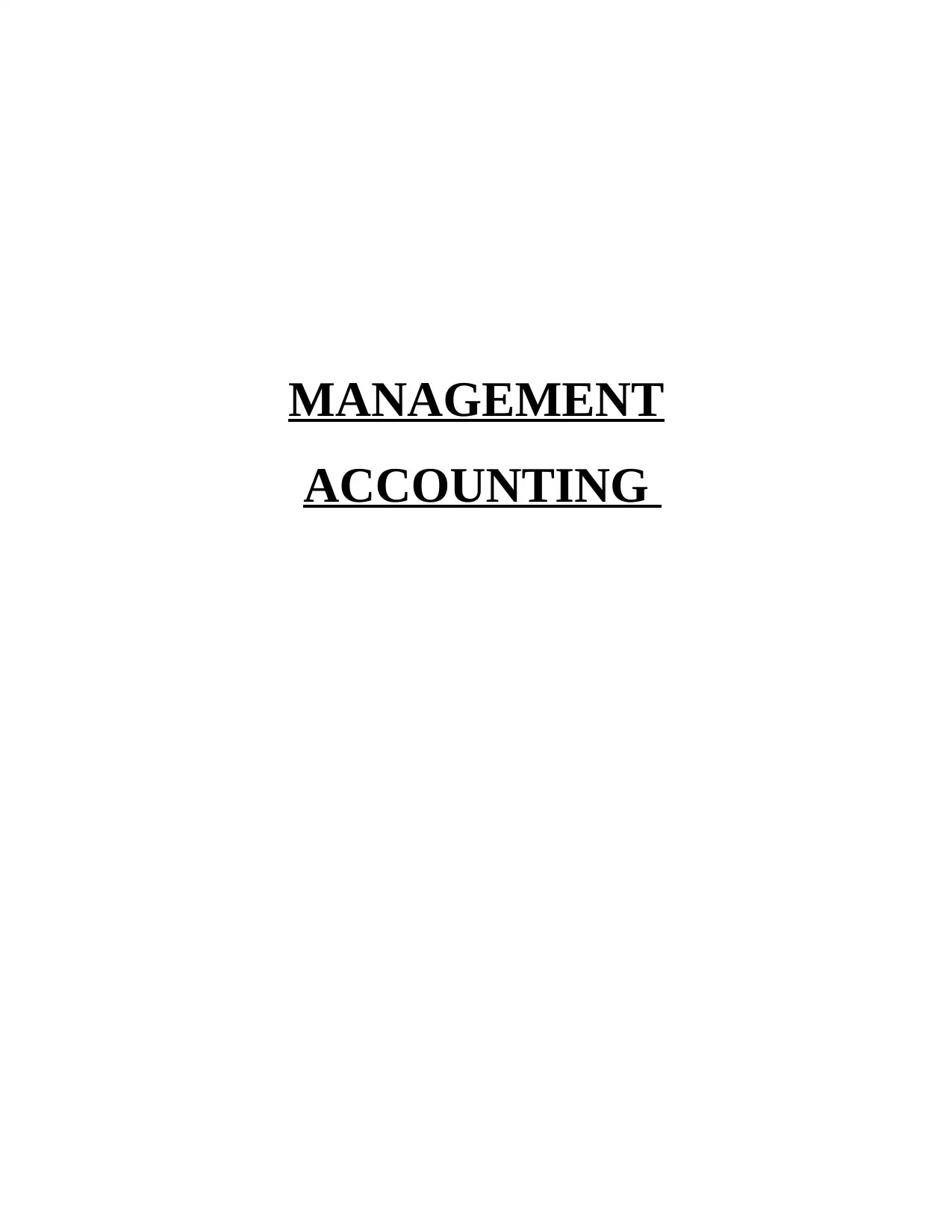
MANAGEMENT
ACCOUNTING
ACCOUNTING
Paraphrase This Document
Need a fresh take? Get an instant paraphrase of this document with our AI Paraphraser
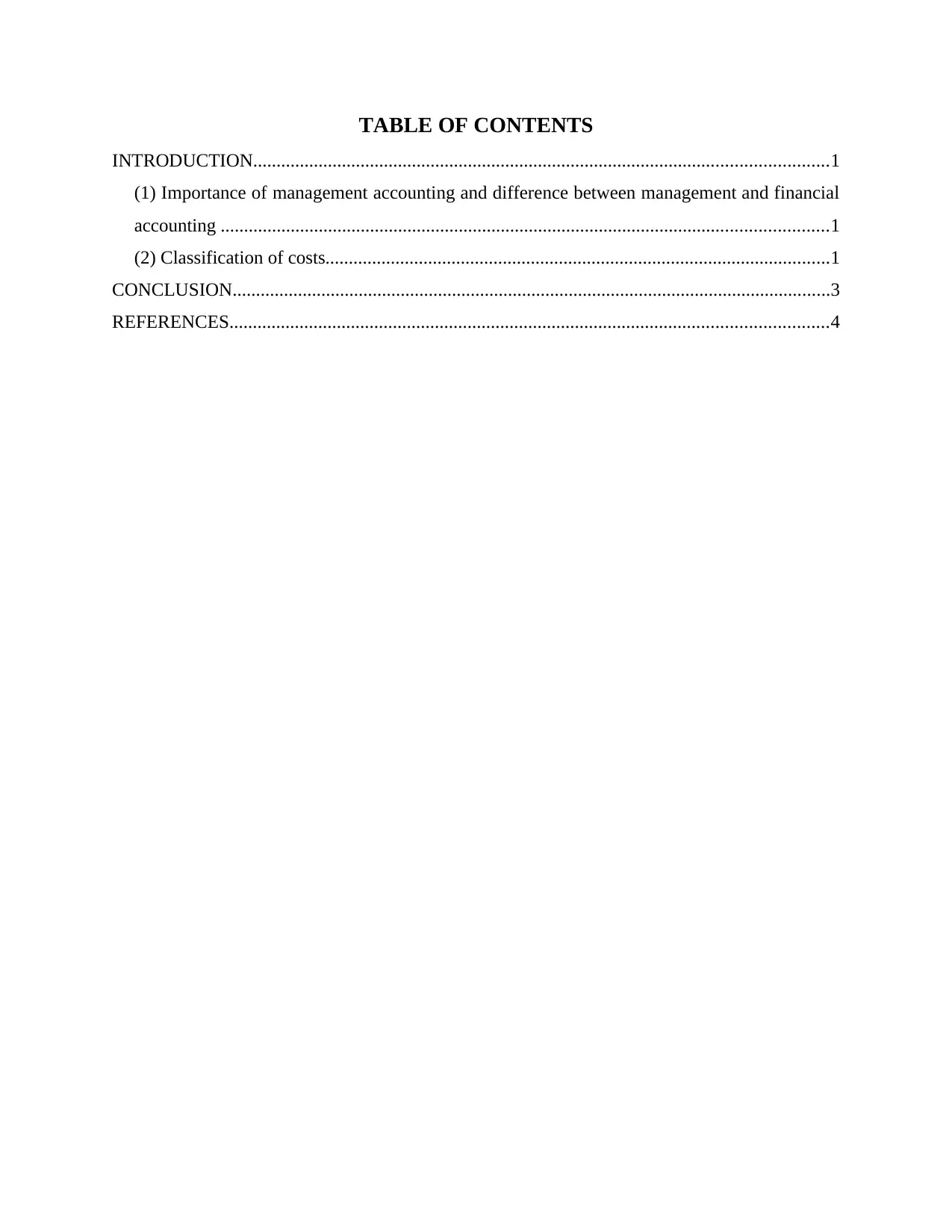
TABLE OF CONTENTS
INTRODUCTION...........................................................................................................................1
(1) Importance of management accounting and difference between management and financial
accounting ..................................................................................................................................1
(2) Classification of costs............................................................................................................1
CONCLUSION................................................................................................................................3
REFERENCES................................................................................................................................4
INTRODUCTION...........................................................................................................................1
(1) Importance of management accounting and difference between management and financial
accounting ..................................................................................................................................1
(2) Classification of costs............................................................................................................1
CONCLUSION................................................................................................................................3
REFERENCES................................................................................................................................4
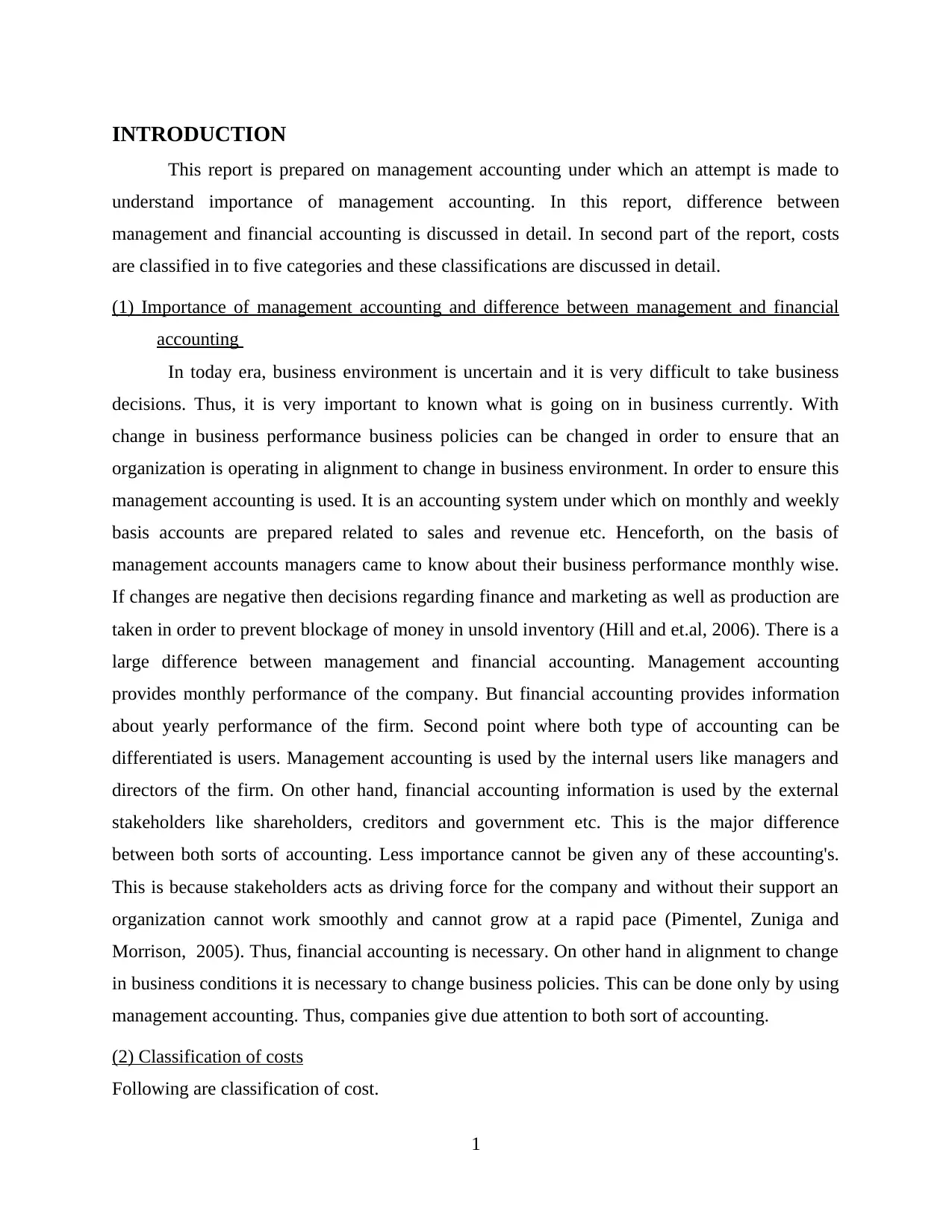
INTRODUCTION
This report is prepared on management accounting under which an attempt is made to
understand importance of management accounting. In this report, difference between
management and financial accounting is discussed in detail. In second part of the report, costs
are classified in to five categories and these classifications are discussed in detail.
(1) Importance of management accounting and difference between management and financial
accounting
In today era, business environment is uncertain and it is very difficult to take business
decisions. Thus, it is very important to known what is going on in business currently. With
change in business performance business policies can be changed in order to ensure that an
organization is operating in alignment to change in business environment. In order to ensure this
management accounting is used. It is an accounting system under which on monthly and weekly
basis accounts are prepared related to sales and revenue etc. Henceforth, on the basis of
management accounts managers came to know about their business performance monthly wise.
If changes are negative then decisions regarding finance and marketing as well as production are
taken in order to prevent blockage of money in unsold inventory (Hill and et.al, 2006). There is a
large difference between management and financial accounting. Management accounting
provides monthly performance of the company. But financial accounting provides information
about yearly performance of the firm. Second point where both type of accounting can be
differentiated is users. Management accounting is used by the internal users like managers and
directors of the firm. On other hand, financial accounting information is used by the external
stakeholders like shareholders, creditors and government etc. This is the major difference
between both sorts of accounting. Less importance cannot be given any of these accounting's.
This is because stakeholders acts as driving force for the company and without their support an
organization cannot work smoothly and cannot grow at a rapid pace (Pimentel, Zuniga and
Morrison, 2005). Thus, financial accounting is necessary. On other hand in alignment to change
in business conditions it is necessary to change business policies. This can be done only by using
management accounting. Thus, companies give due attention to both sort of accounting.
(2) Classification of costs
Following are classification of cost.
1
This report is prepared on management accounting under which an attempt is made to
understand importance of management accounting. In this report, difference between
management and financial accounting is discussed in detail. In second part of the report, costs
are classified in to five categories and these classifications are discussed in detail.
(1) Importance of management accounting and difference between management and financial
accounting
In today era, business environment is uncertain and it is very difficult to take business
decisions. Thus, it is very important to known what is going on in business currently. With
change in business performance business policies can be changed in order to ensure that an
organization is operating in alignment to change in business environment. In order to ensure this
management accounting is used. It is an accounting system under which on monthly and weekly
basis accounts are prepared related to sales and revenue etc. Henceforth, on the basis of
management accounts managers came to know about their business performance monthly wise.
If changes are negative then decisions regarding finance and marketing as well as production are
taken in order to prevent blockage of money in unsold inventory (Hill and et.al, 2006). There is a
large difference between management and financial accounting. Management accounting
provides monthly performance of the company. But financial accounting provides information
about yearly performance of the firm. Second point where both type of accounting can be
differentiated is users. Management accounting is used by the internal users like managers and
directors of the firm. On other hand, financial accounting information is used by the external
stakeholders like shareholders, creditors and government etc. This is the major difference
between both sorts of accounting. Less importance cannot be given any of these accounting's.
This is because stakeholders acts as driving force for the company and without their support an
organization cannot work smoothly and cannot grow at a rapid pace (Pimentel, Zuniga and
Morrison, 2005). Thus, financial accounting is necessary. On other hand in alignment to change
in business conditions it is necessary to change business policies. This can be done only by using
management accounting. Thus, companies give due attention to both sort of accounting.
(2) Classification of costs
Following are classification of cost.
1
⊘ This is a preview!⊘
Do you want full access?
Subscribe today to unlock all pages.

Trusted by 1+ million students worldwide
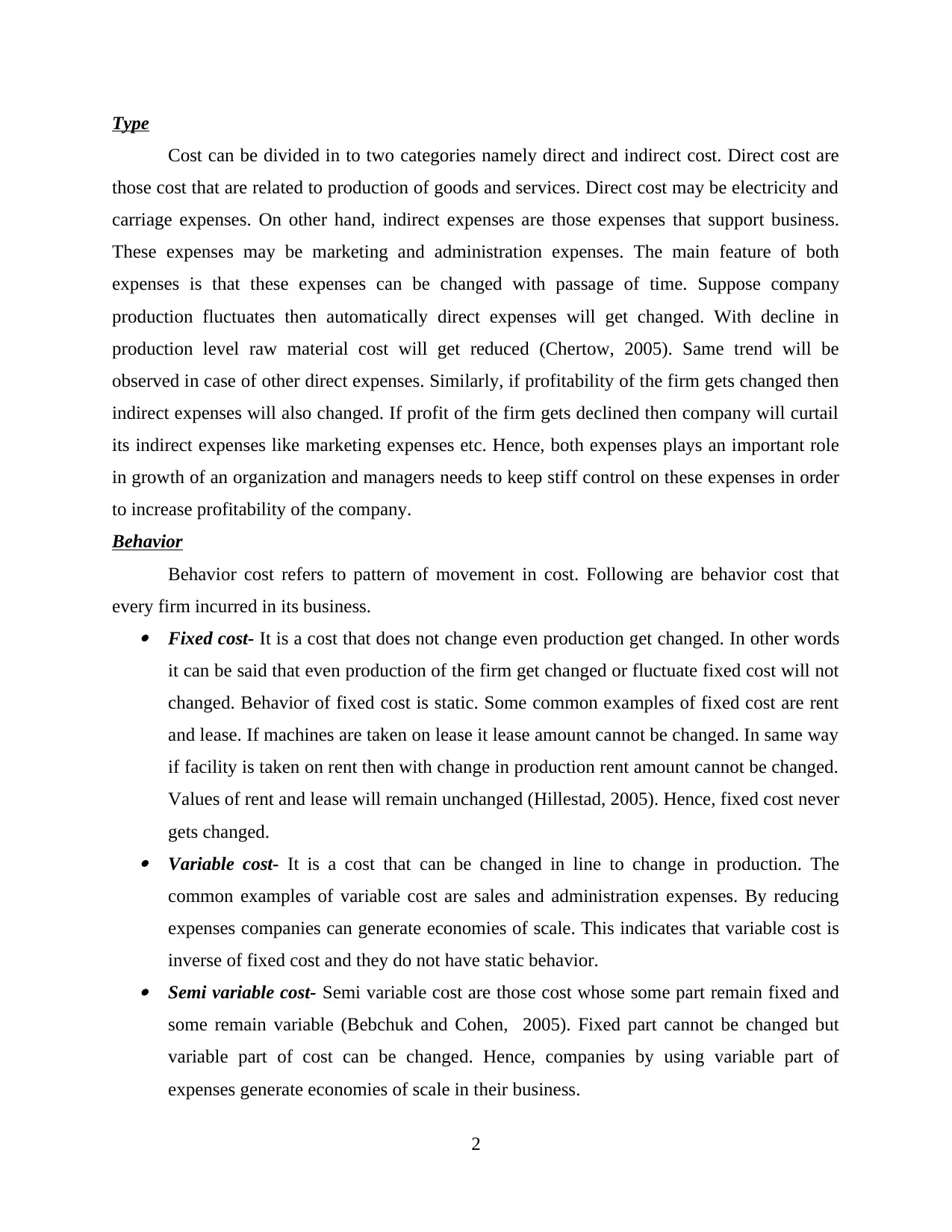
Type
Cost can be divided in to two categories namely direct and indirect cost. Direct cost are
those cost that are related to production of goods and services. Direct cost may be electricity and
carriage expenses. On other hand, indirect expenses are those expenses that support business.
These expenses may be marketing and administration expenses. The main feature of both
expenses is that these expenses can be changed with passage of time. Suppose company
production fluctuates then automatically direct expenses will get changed. With decline in
production level raw material cost will get reduced (Chertow, 2005). Same trend will be
observed in case of other direct expenses. Similarly, if profitability of the firm gets changed then
indirect expenses will also changed. If profit of the firm gets declined then company will curtail
its indirect expenses like marketing expenses etc. Hence, both expenses plays an important role
in growth of an organization and managers needs to keep stiff control on these expenses in order
to increase profitability of the company.
Behavior
Behavior cost refers to pattern of movement in cost. Following are behavior cost that
every firm incurred in its business. Fixed cost- It is a cost that does not change even production get changed. In other words
it can be said that even production of the firm get changed or fluctuate fixed cost will not
changed. Behavior of fixed cost is static. Some common examples of fixed cost are rent
and lease. If machines are taken on lease it lease amount cannot be changed. In same way
if facility is taken on rent then with change in production rent amount cannot be changed.
Values of rent and lease will remain unchanged (Hillestad, 2005). Hence, fixed cost never
gets changed. Variable cost- It is a cost that can be changed in line to change in production. The
common examples of variable cost are sales and administration expenses. By reducing
expenses companies can generate economies of scale. This indicates that variable cost is
inverse of fixed cost and they do not have static behavior. Semi variable cost- Semi variable cost are those cost whose some part remain fixed and
some remain variable (Bebchuk and Cohen, 2005). Fixed part cannot be changed but
variable part of cost can be changed. Hence, companies by using variable part of
expenses generate economies of scale in their business.
2
Cost can be divided in to two categories namely direct and indirect cost. Direct cost are
those cost that are related to production of goods and services. Direct cost may be electricity and
carriage expenses. On other hand, indirect expenses are those expenses that support business.
These expenses may be marketing and administration expenses. The main feature of both
expenses is that these expenses can be changed with passage of time. Suppose company
production fluctuates then automatically direct expenses will get changed. With decline in
production level raw material cost will get reduced (Chertow, 2005). Same trend will be
observed in case of other direct expenses. Similarly, if profitability of the firm gets changed then
indirect expenses will also changed. If profit of the firm gets declined then company will curtail
its indirect expenses like marketing expenses etc. Hence, both expenses plays an important role
in growth of an organization and managers needs to keep stiff control on these expenses in order
to increase profitability of the company.
Behavior
Behavior cost refers to pattern of movement in cost. Following are behavior cost that
every firm incurred in its business. Fixed cost- It is a cost that does not change even production get changed. In other words
it can be said that even production of the firm get changed or fluctuate fixed cost will not
changed. Behavior of fixed cost is static. Some common examples of fixed cost are rent
and lease. If machines are taken on lease it lease amount cannot be changed. In same way
if facility is taken on rent then with change in production rent amount cannot be changed.
Values of rent and lease will remain unchanged (Hillestad, 2005). Hence, fixed cost never
gets changed. Variable cost- It is a cost that can be changed in line to change in production. The
common examples of variable cost are sales and administration expenses. By reducing
expenses companies can generate economies of scale. This indicates that variable cost is
inverse of fixed cost and they do not have static behavior. Semi variable cost- Semi variable cost are those cost whose some part remain fixed and
some remain variable (Bebchuk and Cohen, 2005). Fixed part cannot be changed but
variable part of cost can be changed. Hence, companies by using variable part of
expenses generate economies of scale in their business.
2
Paraphrase This Document
Need a fresh take? Get an instant paraphrase of this document with our AI Paraphraser
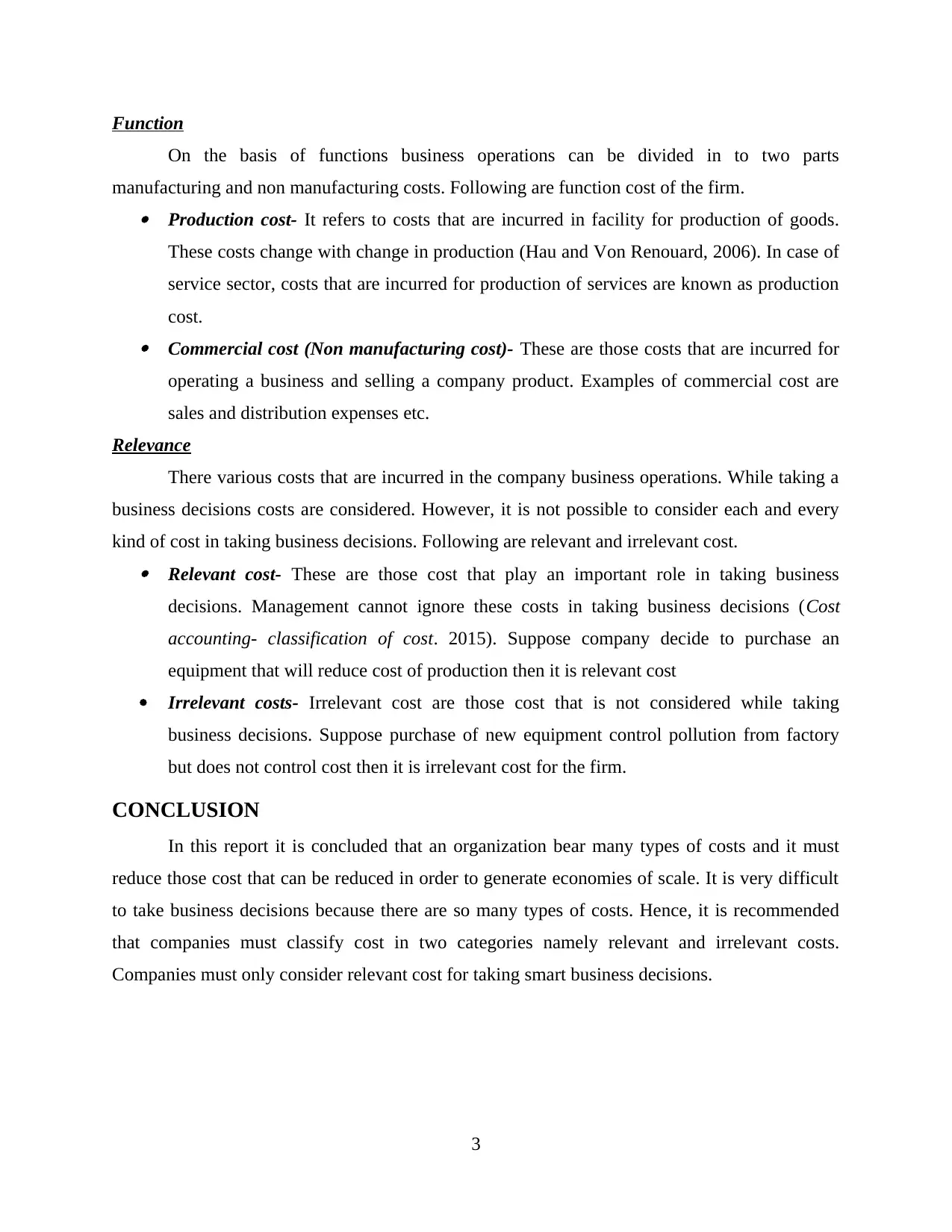
Function
On the basis of functions business operations can be divided in to two parts
manufacturing and non manufacturing costs. Following are function cost of the firm. Production cost- It refers to costs that are incurred in facility for production of goods.
These costs change with change in production (Hau and Von Renouard, 2006). In case of
service sector, costs that are incurred for production of services are known as production
cost. Commercial cost (Non manufacturing cost)- These are those costs that are incurred for
operating a business and selling a company product. Examples of commercial cost are
sales and distribution expenses etc.
Relevance
There various costs that are incurred in the company business operations. While taking a
business decisions costs are considered. However, it is not possible to consider each and every
kind of cost in taking business decisions. Following are relevant and irrelevant cost. Relevant cost- These are those cost that play an important role in taking business
decisions. Management cannot ignore these costs in taking business decisions (Cost
accounting- classification of cost. 2015). Suppose company decide to purchase an
equipment that will reduce cost of production then it is relevant cost
Irrelevant costs- Irrelevant cost are those cost that is not considered while taking
business decisions. Suppose purchase of new equipment control pollution from factory
but does not control cost then it is irrelevant cost for the firm.
CONCLUSION
In this report it is concluded that an organization bear many types of costs and it must
reduce those cost that can be reduced in order to generate economies of scale. It is very difficult
to take business decisions because there are so many types of costs. Hence, it is recommended
that companies must classify cost in two categories namely relevant and irrelevant costs.
Companies must only consider relevant cost for taking smart business decisions.
3
On the basis of functions business operations can be divided in to two parts
manufacturing and non manufacturing costs. Following are function cost of the firm. Production cost- It refers to costs that are incurred in facility for production of goods.
These costs change with change in production (Hau and Von Renouard, 2006). In case of
service sector, costs that are incurred for production of services are known as production
cost. Commercial cost (Non manufacturing cost)- These are those costs that are incurred for
operating a business and selling a company product. Examples of commercial cost are
sales and distribution expenses etc.
Relevance
There various costs that are incurred in the company business operations. While taking a
business decisions costs are considered. However, it is not possible to consider each and every
kind of cost in taking business decisions. Following are relevant and irrelevant cost. Relevant cost- These are those cost that play an important role in taking business
decisions. Management cannot ignore these costs in taking business decisions (Cost
accounting- classification of cost. 2015). Suppose company decide to purchase an
equipment that will reduce cost of production then it is relevant cost
Irrelevant costs- Irrelevant cost are those cost that is not considered while taking
business decisions. Suppose purchase of new equipment control pollution from factory
but does not control cost then it is irrelevant cost for the firm.
CONCLUSION
In this report it is concluded that an organization bear many types of costs and it must
reduce those cost that can be reduced in order to generate economies of scale. It is very difficult
to take business decisions because there are so many types of costs. Hence, it is recommended
that companies must classify cost in two categories namely relevant and irrelevant costs.
Companies must only consider relevant cost for taking smart business decisions.
3
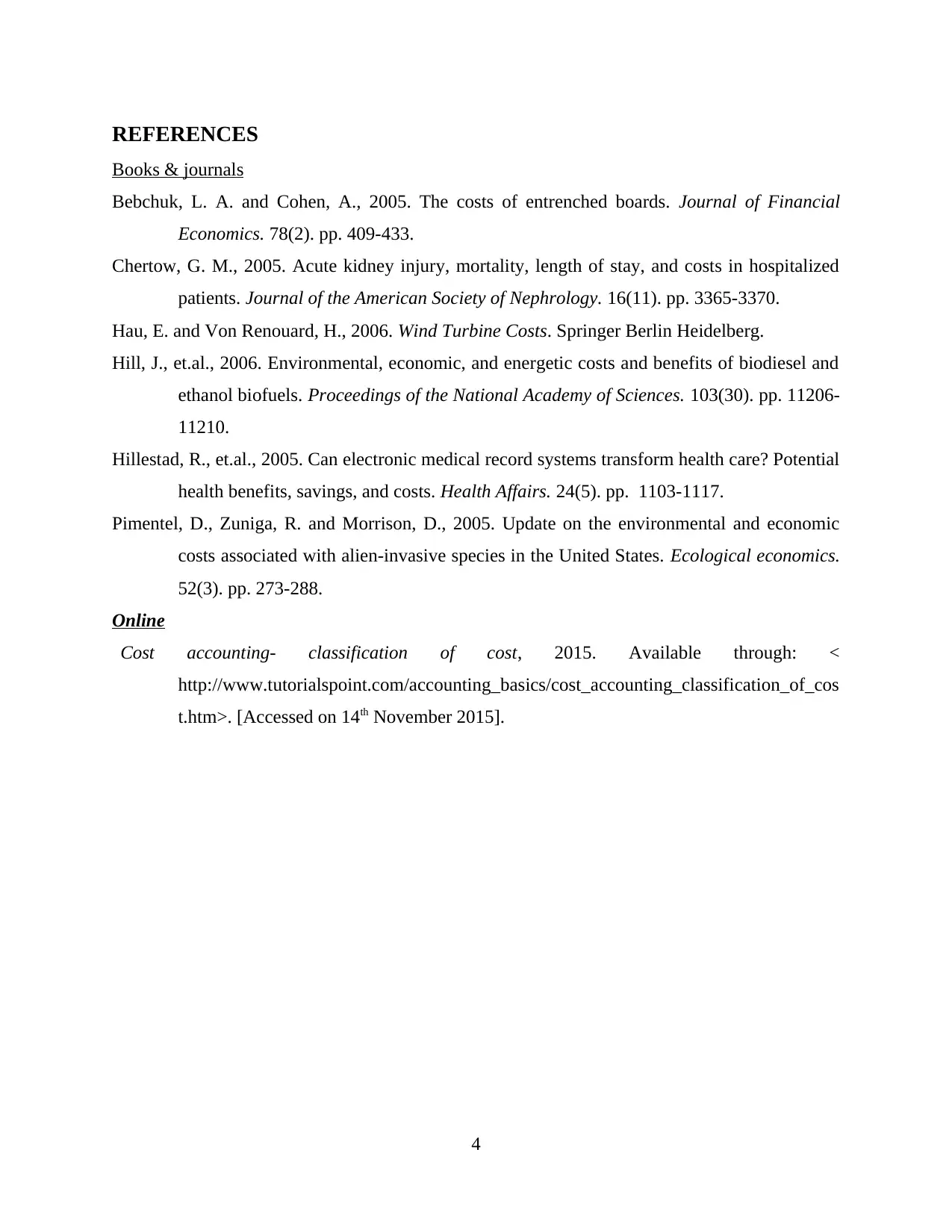
REFERENCES
Books & journals
Bebchuk, L. A. and Cohen, A., 2005. The costs of entrenched boards. Journal of Financial
Economics. 78(2). pp. 409-433.
Chertow, G. M., 2005. Acute kidney injury, mortality, length of stay, and costs in hospitalized
patients. Journal of the American Society of Nephrology. 16(11). pp. 3365-3370.
Hau, E. and Von Renouard, H., 2006. Wind Turbine Costs. Springer Berlin Heidelberg.
Hill, J., et.al., 2006. Environmental, economic, and energetic costs and benefits of biodiesel and
ethanol biofuels. Proceedings of the National Academy of Sciences. 103(30). pp. 11206-
11210.
Hillestad, R., et.al., 2005. Can electronic medical record systems transform health care? Potential
health benefits, savings, and costs. Health Affairs. 24(5). pp. 1103-1117.
Pimentel, D., Zuniga, R. and Morrison, D., 2005. Update on the environmental and economic
costs associated with alien-invasive species in the United States. Ecological economics.
52(3). pp. 273-288.
Online
Cost accounting- classification of cost, 2015. Available through: <
http://www.tutorialspoint.com/accounting_basics/cost_accounting_classification_of_cos
t.htm>. [Accessed on 14th November 2015].
4
Books & journals
Bebchuk, L. A. and Cohen, A., 2005. The costs of entrenched boards. Journal of Financial
Economics. 78(2). pp. 409-433.
Chertow, G. M., 2005. Acute kidney injury, mortality, length of stay, and costs in hospitalized
patients. Journal of the American Society of Nephrology. 16(11). pp. 3365-3370.
Hau, E. and Von Renouard, H., 2006. Wind Turbine Costs. Springer Berlin Heidelberg.
Hill, J., et.al., 2006. Environmental, economic, and energetic costs and benefits of biodiesel and
ethanol biofuels. Proceedings of the National Academy of Sciences. 103(30). pp. 11206-
11210.
Hillestad, R., et.al., 2005. Can electronic medical record systems transform health care? Potential
health benefits, savings, and costs. Health Affairs. 24(5). pp. 1103-1117.
Pimentel, D., Zuniga, R. and Morrison, D., 2005. Update on the environmental and economic
costs associated with alien-invasive species in the United States. Ecological economics.
52(3). pp. 273-288.
Online
Cost accounting- classification of cost, 2015. Available through: <
http://www.tutorialspoint.com/accounting_basics/cost_accounting_classification_of_cos
t.htm>. [Accessed on 14th November 2015].
4
⊘ This is a preview!⊘
Do you want full access?
Subscribe today to unlock all pages.

Trusted by 1+ million students worldwide
1 out of 6
Related Documents
Your All-in-One AI-Powered Toolkit for Academic Success.
+13062052269
info@desklib.com
Available 24*7 on WhatsApp / Email
![[object Object]](/_next/static/media/star-bottom.7253800d.svg)
Unlock your academic potential
Copyright © 2020–2025 A2Z Services. All Rights Reserved. Developed and managed by ZUCOL.



